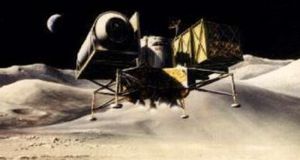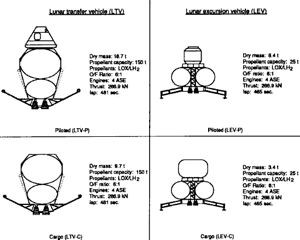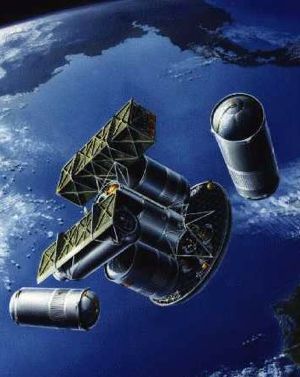
Home - Search - Browse - Alphabetic Index: 0- 1- 2- 3- 4- 5- 6- 7- 8- 9
A- B- C- D- E- F- G- H- I- J- K- L- M- N- O- P- Q- R- S- T- U- V- W- X- Y- Z
LEV
 LEV Lunar Excursion Vehicle Credit: NASA |
AKA: Lunar Excursion Vehicle. Status: Study 1989. Gross mass: 28,400 kg (62,600 lb). Unfuelled mass: 3,400 kg (7,400 lb). Specific impulse: 465 s.
It was conceived to transfer personnel and cargo between low lunar orbit and the lunar surface (these having been delivered there from a NASA space station by an Orbital Transfer Vehicle / Lunar Transfer Vehicle). It was usually derived from the OTV hardware but only a fraction of the OTV's size so that the OTV could deliver it to lunar orbit in a single flight. Precise mass figures varied from study to study depending on earth launch vehicle and OTV sizing assumptions.
A typical study differentiated between personnel vehicles, which could accommodate up to eight crewmembers, and cargo vehicles. LEVs would be based and serviced on the lunar surface at the lunar outpost. The vehicles had an assumed reuse lifetime of 10 missions.
An important design concept of this case study was the extensive use of vehicle commonality. Common LEVs that could be used for either a pure cargo mission or a combined personnel and cargo mission kept the lunar outpost overhead to a minimum. A single vehicle design required a smaller inventory of spare parts, fewer systems for the crew to understand, and the ability to interchange vehicle parts. Also, a common design eliminated the need for separate backup vehicles for personnel or cargo missions, thus minimizing the number of LEVs on the lunar surface and providing inherent redundancy and mission safety.
The LEV used the same engines and liquid oxygen/liquid hydrogen propellants as the OTV/. The engines on the LEV employed a smaller nozzle than their OTV counterparts, which resulted in a lower engine specific impulse. However, the smaller nozzle allowed the LEV to have short landing legs and reduced dry mass. When an LEV was used for a cargo mission, only unmanned payloads were loaded onto the LEV and delivered to the lunar surface. For a personnel mission, a crew module was attached to the LEV, and both crew and payloads were delivered to the lunar surface. The personnel LEV used four ASE engines with a thrust of 266.9 kN, a specific impulse of 465 seconds at an O:F ratio of 6:1. It had a dry mass of 6.4 metric tons (including the 3 metric ton crew module), and a capacity of 25 metric tons of propellant. The cargo LEV-C was the same, except that deletion of the crew module decreased the empty mass to 3.4 metric tons. Actual propellant loading would vary little - between 23.8 metric tons and 24.9 metric tons depending on the mission, with payload carried varying from 15.2 metric tons to 37.0 metric tons depending on the version (expendable or reusable) and mission.
Family: Lunar Landers. Country: USA. Engines: ASE. Propellants: Lox/LH2. Agency: NASA.
 | LEV / LTV Lunar Excursion Vehicle / Lunar Transfer Vehicle variants Credit: NASA |
 | LTV Lunar Transfer Vehicle dropping propellant tanks Credit: NASA |
 | LEV Lunar Excursion Vehicle |
Back to top of page
Home - Search - Browse - Alphabetic Index: 0- 1- 2- 3- 4- 5- 6- 7- 8- 9
A- B- C- D- E- F- G- H- I- J- K- L- M- N- O- P- Q- R- S- T- U- V- W- X- Y- Z
© 1997-2019 Mark Wade - Contact
© / Conditions for Use